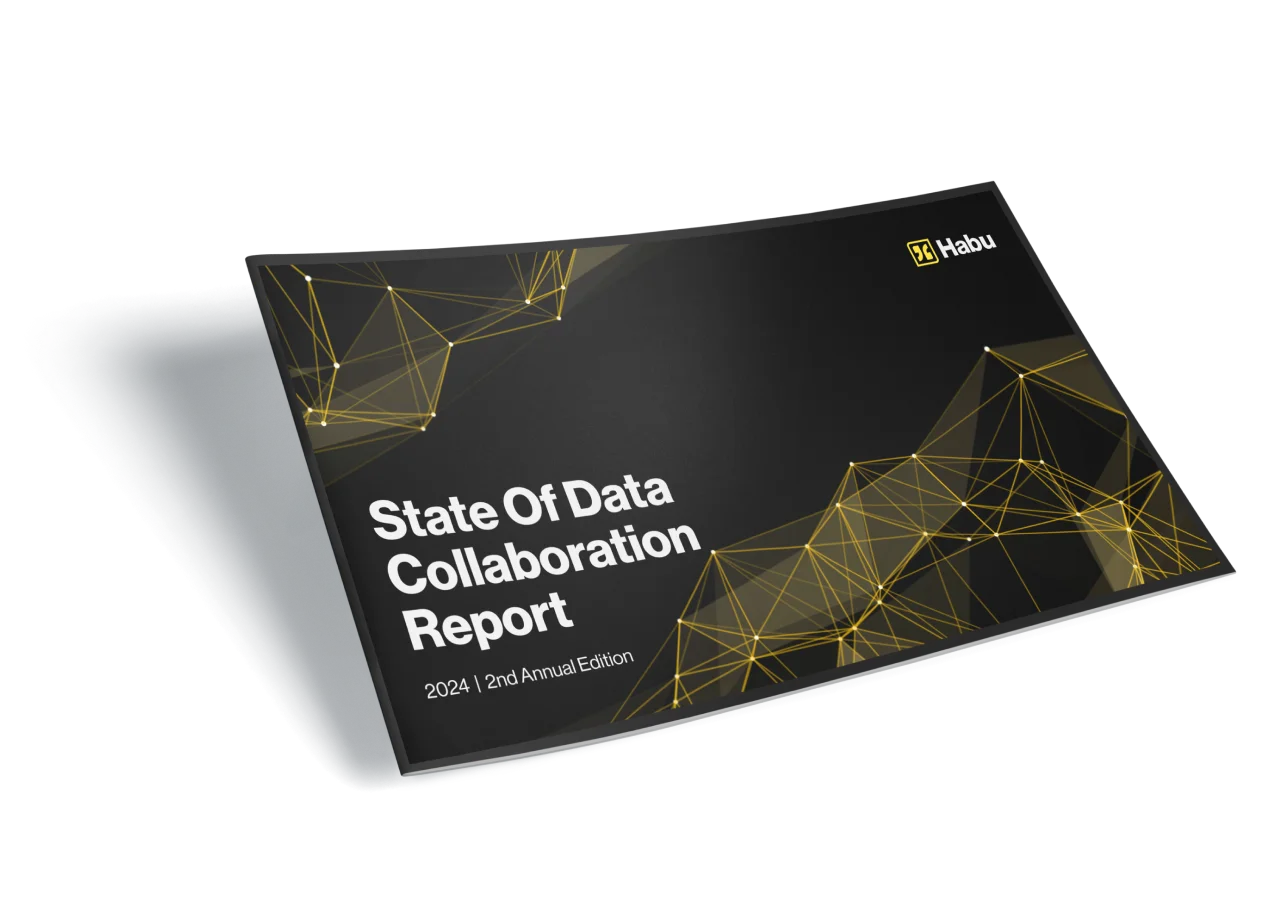The digital gold rush is well underway as companies across all industries look to leverage the power of customer data. From media consumption habits to purchase intentions and spending habits, companies around the world accumulate massive amounts of information from their customers. According to Statista, over 70% of companies in the United States and European Union collect personal data.
This presents a massive opportunity for companies looking to address consumer needs on a personalized level. In fact, Gartner predicts that organizations that invest in and promote external data sharing will outperform competitors across key business metrics — achieving 3x the economic benefits.
Unfortunately, they also predict that less than 5% of companies will perform data sharing correctly. This is particularly problematic, considering companies soon won’t be able to rely on third-party cookies to understand customer behavior.
In this blog, we’ll look at the current state of data sharing for data-driven businesses, examining how the enterprise stakeholders who own and collaborate with data can share and access it more effectively while maintaining privacy.
What Is Data Sharing?
In today’s increasingly digital world, data sharing has become a cornerstone for informing and driving personalized interactions. At its core, data sharing is the practice of making a specific set of data available to multiple parties. As businesses and organizations become more digitally inclined, there’s a growing emphasis on ensuring that data is shared securely and safely. This is especially crucial in business environments where sensitive information is often at play.
The benefits of proper data sharing are manifold, especially when facilitated through platforms like data clean rooms. These platforms allow industry-leading enterprises to:
- Easily expand partnership networks: By expanding their partnership network with an interoperable solution, mega-brands like Disney and PepsiCo further leverage their data to shore up revenue streams.
- Create personalized customer experiences: With access to more data, businesses like GM can use clean rooms to better understand customers’ preferences and behaviors, allowing them to tailor experiences that resonate more deeply with their target audience.
- Collaborate efficiently and safely: Companies across industries now use clean rooms to do more with their data while preserving privacy and compliance.
Effective data sharing bridges the gap between those who own the data and those who utilize it. This synergy ensures that data is not just hoarded but put to good use, driving innovation and growth.
Who Needs Data Sharing?
Data sharing is not a one-size-fits-all concept. Different enterprises have different roles when it comes to data sharing. Broadly, you can categorize these roles into two profiles: data owners and data collaborators.
Data Owners
Data owners are businesses that possess vast data and partnership networks. They are the custodians of unique data sets and are responsible for its safekeeping and access control. Media companies, financial service firms, and healthcare providers are examples of companies with rich data sets.
Data Collaborators
Data collaborators might not own the data, but they utilize it for various purposes. This includes data from walled gardens like Amazon, Google, Meta, and private data clean rooms. Roles that typically fall under this profile are marketers and media buyers.
Several industries recognize the importance of robust data sharing processes, either due to legal imperatives or strategic advantages. These industries include:
- Media: In an age of streaming and digital content, media companies rely on data sharing to understand viewer preferences, optimize ad placements, and tailor content to specific audiences.
- Retail: Retailers use shared data to understand buying patterns, optimize inventory, and create personalized shopping experiences.
- Travel: Travel agencies and airlines share data to optimize routes, understand traveler preferences, and offer tailored packages.
- Automotive: With the rise of smart vehicles, data sharing helps automotive companies understand driving patterns, optimize vehicle performance, and predict maintenance needs.
- Healthcare: Data sharing in healthcare can improve patient outcomes by providing a comprehensive view of patient histories, facilitating research, and enabling timely interventions.
- Finance: Financial institutions rely on shared data to assess creditworthiness, detect fraud, and offer personalized financial products.
By bridging the gap between data owners and collaborators, businesses not only unlock a treasure trove of insights but simultaneously address some of the major challenges facing industries reliant on consumer data.
Why the Digital Enterprise Needs to Embrace Data Collaboration
In the digital age, data likens to oil — a valuable resource that powers the modern enterprise. Proper data sharing drives profits and maintains security across a myriad of industry use cases. As businesses transition into the digital and cloud era, the importance of data collaboration becomes even more pronounced. This is primarily due to three pivotal reasons: new privacy regulations, the shift from third-party to first-party data, and the decentralization of data.
Customer Data Protection Regulations
The digital landscape is constantly evolving, and with it comes a slew of regulations that dictate how companies can collect, store, and share data. These regulations protect consumer privacy and ensure that businesses handle data responsibly.
EU’s General Data Protection Requirements (GDPR): Introduced by the European Union, the GDPR is a comprehensive data protection law that impacts businesses operating within the EU. It mandates that companies must obtain explicit consent from users before collecting their data. Additionally, users have the right to access, modify, or delete their data. Noncompliance can result in hefty fines, making it imperative for businesses to adhere to its guidelines.
California Consumer Privacy Act (CCPA): The CCPA is a state-level regulation in California that grants consumers the right to know what personal data people are collecting about them, the purpose of its collection, and with whom it’s being shared. It also allows consumers to opt out of the sale of their personal data.
California Privacy Rights Act: Building on the CCPA, this act further strengthens data protection rights for Californians, offering more control over their personal data and ensuring businesses maintain transparency in their data practices.
These regulations underscore the need for businesses to adopt clean room solutions. Clean rooms allow for effective and compliant data sharing, ensuring that businesses can leverage data insights without violating privacy laws.
Shift From Third- to First-Party Data
The digital data landscape is undergoing a significant transformation. Driven by legislation and growing consumer concerns about data privacy, tech giants are taking charge, redefining the rules of data collection and sharing. Companies like Apple and Google are at the forefront of this change.
Apple, for instance, is limiting in-app tracking, giving users more control over their data. Google, on the other hand, is phasing out the use of third-party cookies in Chrome. This move will significantly impact advertisers and businesses that rely on third-party data for targeted advertising.
The shift from third-party to first-party data means that businesses now need to rely more on data they collect directly from their customers. This data is more reliable and relevant, but it also means businesses need to invest more in building direct relationships with their customers.
Data Decentralization
The decline of third-party data brokers and the emphasis on first-party data have led to a new challenge: data decentralization. Customer data is now scattered or siloed across various stores.
First-party data: Companies collect this data directly from their customers. It could be through online interactions, purchases, or feedback. This data is stored internally and offers valuable insights into customer behavior and preferences.
Second-party data: Strategic partners and media brands collect this data. It’s essentially another company’s first-party data used for collaborative efforts.
To truly harness the power of customer data, companies need to access information from a variety of sources. This includes:
- Walled gardens: Platforms like Facebook, Amazon, and Google, where data resides within their ecosystem and is not easily accessible to outsiders.
- Cloud data stores: Modern businesses often store their data in the cloud and data warehouses, making it essential to have solutions that can seamlessly access and integrate this data.
- Activation and identification partners: These are entities that help businesses identify and activate their data, ensuring it’s put to optimal use.
The digital enterprise of today stands at a crossroads. The old ways of data collection and sharing are being replaced by more transparent, consumer-centric practices. While this presents challenges, it also offers opportunities for businesses to build stronger, more meaningful relationships with their customers. By embracing data collaboration and understanding the evolving landscape, businesses can not only ensure compliance but also unlock new avenues for growth and innovation.
Unlock Customer Insights With a Data Clean Room Platform
A data clean room is a cutting-edge, privacy-centric environment where data owners and collaborators converge to access aggregate customer data. This secure setting ensures partners can join and analyze data without exposing raw details. A modern clean room platform provides five essential functions for any organization that owns or collaborates with data:
- Full interoperability without data movement
- Robust privacy and governance features
- Diverse analytics tools for multiple use cases
- A fortified setting for data science modeling
- Seamless multi-party collaboration
Embracing such a platform can unlock unparalleled customer insights, driving business growth.
While it may seem that the digital gold rush is drying up, organizations with strong data-sharing practices and networks can unlock insights while providing users with a better online experience. Start collaborating today with Habu’s data clean room platform.




